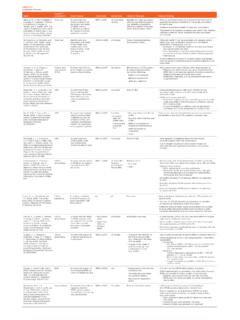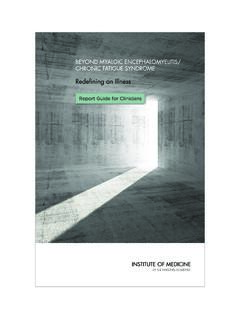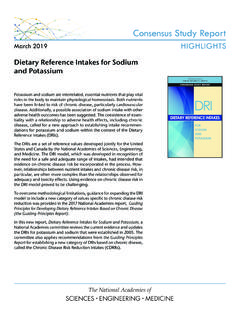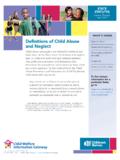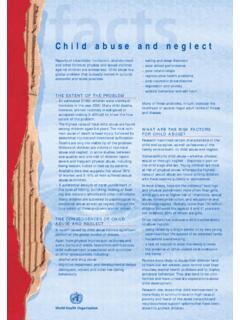Transcription of IOM Child Abuse Neglect Research Questions
1 NEW DIRECTIONS: Questions TO GUIDE F UTURE CHI L D. Abuse AND NEGL ECT Research . New Directions in Child Abuse and Neglect Research , a report by the Institute of Medicine (IOM) and National Research Council (NRC), emphasizes that Child Abuse and Neglect are serious public health issues. Building on Research findings gleaned during the past 20 years, the report calls for a systems approach to Child Abuse and Neglect Research and highlights the importance of adopting a critical stratification lens1 in considering the impact of social and economic factors on Child Abuse and Neglect . Addressing these public health problems will require an expanded Research response that is grounded in the complex environments and systems within which Child Abuse and Neglect occur (see figure pg.)
2 2). The purpose of this document is to guide researchers toward new directions in Child Abuse and Neglect Research . TRENDS. Research has revealed strong evidence indicating that sexual Abuse has declined substantially in the past two decades, as well as a decline in physical Abuse , especially the more common and less severe forms. There is no evidence, however, that Neglect is declining overall. These disparate trends and their causes currently are not well understood. Future Research in this area could focus on the following Questions . What accounts for the declines in the rates of sexual Abuse and the most common forms of physical Abuse (areas for study might include the development and availability of effective prevention interventions, the decline in intimate partner violence, or successful public awareness campaigns)?
3 What explains the inconsistent trends across types of Child Abuse and Neglect ? What explains significantly different rates of Neglect across states in terms of whether they are increasing, decreasing, or remaining constant ( , variations in definitions of Neglect , differences among data sources used for analysis, or real differences in rates related to availability of resources)? 1. Stratification involves the rank ordering of people based on their social and economic traits. Research PRIORITIES IN Child Abuse AND Neglect . CAUSES AND CONSEQUENCES SERVICES IN COMPLEX SYSTEMS AND POLICY. Improve understanding of the separate Explore highly effective delivery systems. and synergistic consequences of Develop and test new programs for different forms of Child Abuse and underserved children and families.
4 Neglect . Identify the best means of replicating Initiate high-quality longitudinal studies effective interventions and services with of Child Abuse and Neglect . fidelity. Target innovative Research on the Identify the most effective ways to causes of Child Abuse and Neglect . implement and sustain evidence-based Improve understanding of the behavioral programs in real-world settings. and neurobiological mechanisms that Investigate the longitudinal impacts of mediate the association between Child prevention. Abuse and Neglect and its sequelae. Encourage Research designed to provide a better understanding of trends in the incidence of Child Abuse and Neglect . Evaluate the impact of laws and policies that address prevention and intervention systems and services for Child Abuse and Neglect at the federal, state, and local levels.
5 DISENTANGLE THE ROLE OF CULTURAL PROCESSES, SOCIAL STRATIFICATION INFLUENCES, ECOLOGICAL. VARIATIONS, AND IMMIGRANT/ACCULTURATION STATUS. APPLY MULTIDISCIPLINARY, MULTIMETHOD, AND MULTISECTOR APPROACHES. LEVERAGE AND BUILD UPON THE EXISTING KNOWLEDGE BASE OF Child Abuse AND Neglect Research . AND RELATED FIELDS, AS WELL AS Research DEFINITIONS, DESIGNS, AND OPPORTUNITIES. 2 NEW DIRECTIONS: Questions to Guide Future Child Abuse and Neglect Research THE INTERPLAY OF RISK FACTORS, PROTECTIVE FACTORS, RESILIENCY, AND OUTCOMES. A body of knowledge exists that identifies associations among a variety of potential risk factors and Child Abuse or Neglect at each of the ecological levels (individual-level, family, community, and contextual factors). Many of the risk factors that have been identified are interrelated and seldom are present in isolation.
6 All of these factors describe circumstances surrounding elevated risk for Child Abuse and Neglect , but none of these individual or contextual factors has been shown to cause Child Abuse and Neglect . In terms of prevention, relatively little is known about factors that protect at-risk children from being abused or neglected. Future Research in this area could focus on the following topics. How does the complex interaction among multiple risk and protective factors influence resiliency of children who have experienced Child Abuse and Neglect ? Which factors (across multiple levels of the social ecology) put children at risk for one or more types of Abuse or Neglect ? Which factors (across multiple levels of the social ecology) protect children from experiencing one or more types of Abuse and Neglect in families at risk?
7 How do different types of Abuse impact a Child 's developmental trajectory? What leads some individuals and families to benefit more or less from prevention and treatment programs? What are the behavioral, neurobiological, social, and environmental mechanisms that mediate the association between exposure to Abuse and Neglect and their behavioral and neurobiological sequelae? What factors or processes increase the likelihood that some children and families experience different outcomes when faced with the same risks? What factors are linked to differential sensitivity of children across similar types of Abuse ? Why do certain factors result in Abuse or Neglect in some situations but not others? Are there differences in how risk and protective factors play out across diverse cultural groups?
8 How do characteristics of alternative or complex family structures ( , single parent, nonmarital cohabitating partners, or having children by multiple partners) influence risk and protective factors in Child Abuse and Neglect ? How can we better identify families at risk in order to guide prevention efforts? What are the paternal characteristics that place children at risk for, or serve to protect at-risk children from, Abuse and Neglect ? What role does a community's acceptance of elevated levels of violence or social attitudes about violence play in relation to rates of physical Abuse ? NEW DIRECTIONS: Questions to Guide Future Child Abuse and Neglect Research 3. APPROACHES, PRACTICES, AND STRATEGIES WITH EVIDENCE FOR EFFECTIVENESS. Significant progress has been achieved in developing strategies to reduce Child Abuse and Neglect , ameliorate its consequences, and improve parental capacity.
9 Research advances made during the past two decades provide a solid base for moving forward. Future Research in this area could focus on the following Questions . How many and what types of interventions should be readily available for families in the Child welfare system? Is a single evidence-based intervention more effective for both Child and system outcomes than multiple services designed to address the many different problems families may have? What strategies need to be devised for better reaching, engaging, and retaining target populations? What are the core elements of evidence-based programs, that is, those required elements that fundamentally define their nature and produce their main effects that should not be altered when adapting a program to local contexts and needs?
10 Are evidence-based practices equally effective with understudied ethnic and cultural groups who are at risk for or experience Child Abuse or Neglect ? Do understudied ethnic youth have a greater benefit from culturally adapted interventions? Under what circumstances should evidence-based interventions be culturally adapted, and how should the adapted interventions be assessed? What strategies are needed to sustain the positive impacts of home visiting approaches when proven models are taken to scale? What factors guide successful implementation of differential response and ensure desired outcomes, and to what extent does this approach work within different contexts? In terms of the effectiveness or impact of differential response approaches, how do different definitions of Abuse and Neglect , varied criteria for the assessment pathway, unique approaches to service provision, and adequate funding for services contribute to outcomes?





